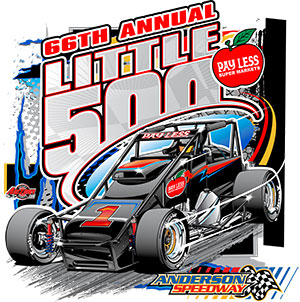|


SATURDAY, MAY 24, 2014
|
66th Pay Less Little 500 Tires Announced |
(March
17,
2014) - Hoosier
Racing Tires officials have announced
details on tires for the 2014 running of the
Pay Less Little 500.
RR 17/28-15 M40
LR 25.5/13-15 2020 or M30
LR 26/13-15 M20 or M30
RF 12/25-15 2045
RF 11/24.5-15 2045
LF 11/24.0-15 2010
LF 8/23.5-15 M10
|
How It All Began...
The quarter-mile Anderson Speedway was
built in 1948 by legendary promoter Joe Helpling and a large group of men
working for 25 cents per hour. Although Helpling had planned on constructing a
bowling alley and recreation center on his 32 acre tract at 29th street and
Pendleton Avenue, two Anderson city councilmen suggested that he instead
consider building a racetrack.
Helpling had never seen a race of any
type, so he traveled to Armscamp Speedway in Alexandria and 16th Street Speedway
in Indianapolis (Both tracks are no longer in existence) to get some ideas.
After those visits, the decision was made: it was racing.
In 1948, Sun Valley Speedway (as it
was originally known) officially opened for competition. The Roaring Roadsters
and AAA Midgets were the most popular programs, so Helpling decided to present
an idea to members of the Mutual Racing Association, which was the sanctioning
body for the Roadsters during that period.
A press conference was held in early
1949 at the old Anderson Hotel, where Helpling unveiled his idea to start 33
roadster in a 500-lap event.
Everybody scoffed and said that it
would never work. Pressure was put on Helpling to reduce the race length to 200
or 300 laps, because it would probably cost $800 per car for tires and no car
would finish.
"Then we'll run bicycles," Helpling
said." Because we're gonna have a Little 500 and that's the way it's gonna be."
In the inaugural event, to the
surprise of most, 18 roadsters finished, five of which did not even make a pit
stop. Sam Skinner won that event, with Bob Block finishing second and Tom Cherry
filling out the podium finishers.
|